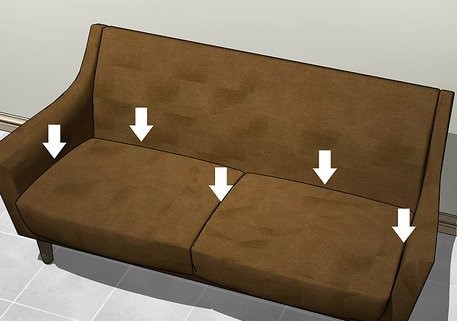Against what their name indicates, bed bugs do not confine themselves to your bed. The last thing you want to see is bed bugs on your couch and other furniture around your home. Getting rid of bed bugs in furniture is challenging because they can get deep into cushions or the furniture’s body.
But don’t worry; you can treat bed bugs in your furniture. This post takes you through everything you need to know about treating bed bugs on your furniture.
Table of Contents
How Do Bed Bugs Get In Furniture?
Bed bugs are predominantly hitchhiker bugs that migrate from place to place in search of human blood to feed and suitable breeding conditions. They primarily find their way onto your furniture by hitching rides on clothes, luggage, and other personal belongings. You ought to be watchful when you visit new places or friends’ homes to avoid bringing bed bugs into your home.
Citing recent research, a post on NBC news notes that bed bugs can crawl as far as a 20-foot radius. This means that bed bugs can crawl from their original harborage location, for example, your bed, onto furniture. Since they are after your blood, they will likely crawl onto your couch if you spend more time on it.
Types of Furniture That Can Get Bed Bugs
Bed bugs can infest all kinds of furniture. They are not confined to those in your bedroom, as most people would like to believe. While they are primarily nocturnal, they can come out to feed on you during the day. This means your favorite living room couch is just as good for a bed bug as your bedroom’s. Nonetheless, the pieces of furniture in the bedroom are at higher risk considering their proximity to hot spots. These pieces of furniture include:
- Bed
- Bedside table
- Desk
- Armchairs
- Coffee table
- Dresser
- Couch
- Nightstand
Pieces of furniture with lots of cracks and crevices are also at a higher risk of contracting bed bugs. The pesky bugs use the existing cracks, joints, and crannies to hide as they lie in wait for unsuspecting victims. These gaps in furniture are also perfect for bed bugs because they offer dark and sometimes humid conditions suitable for breeding.
Pieces of furniture with leather upholstery are not climber-friendly for bed bugs. Nonetheless, contaminated furniture with leather upholstery is hard to treat. This is because tears on the upholstery are inaccessible for bed bug treatment.
Signs of Bed Bugs in Furniture
The telltale signs of bed bugs are practically the same everywhere. You must develop a keen eye and carry out thorough and regular inspections. Here are the common signs you should look out for:
- You will see bed bug excrements that appear as dark and rusty spots on your furniture and fabrics. They may sometimes be reddish due to bed bugs being crushed.
- Bed bug eggs, eggshells, and exoskeletons are usually tiny at about 1mm. It is best to use a UV flashlight when searching for bed bug exoskeletons as they emit a distinct blue light.
- A musty, sweet odor if the infestation is massive. Some people may perceive the smell as strong and acidic. This scent is what trained bed bug detection dogs sniff out.
- You will see live bugs when the infestation is at an advanced stage. In this case, you will find some bed bugs grouped around furniture joints, cracks, and crevices.
How to inspect bed bugs in furniture
Bed bugs are tiny, with an adult the size of an apple seed. If you can fit a credit card in any gap on your furniture, bed bugs can get in. Considering that pieces of furniture have very tight spaces, you need an assortment of tools to perform a thorough inspection. These tools include:
- Plain white sheet made of either paper, cardboard, or just clothing
- White latex glove
- Flashlight
- A hard flat object like a credit card, spatula, putty knife, or a piece of wood
- Spanners, hammer, screwdrivers, or pliers (optional depending on infestation size)
- Magnifying glass
- Alcohol or baby wipes or just cotton and alcohol
- Sealable plastic bags or small jars or containers to collect samples
There are as many options that are at your disposal as you can think. The first thing to do is to identify potential hot zones for bed bug infestations like cracks, joints, crevices, folds, tucks, and the underside of your furniture. The tools above help in your inspection depending on the size of the infestation or your end game.
Once you have identified these areas, it is time to pick the necessary tools for inspection. For example, tight cracks and joints may not be accessible with a spanner, hammer, or screw. In such a scenario:
- Place the white cloth or paper on the Ground or any surface under the crack or grooves.
- Run the credit card, spatula, or putty knife stiffly 2 to 3 times through the groove or joint.
- Inspect the white surface for black pellets-like droppings or bed bug exoskeleton. (Examine the white surface using a UV flashlight and a magnifying glass)
Alternatively, you can:
- Rub the suspected surface groove or crack with baby wipes, alcohol wipes, or cotton soaked in alcohol.
- Inspect the wipes for rusty brown stains or red stains and black pellets.
- Use a magnifying glass, as these pellets are tiny and may be mistaken for dirt or chips.
Chances are that all the above efforts have not yielded results. It may be that there are no bed bugs after all. If you are still unsatisfied, you can take apart the furniture using a screwdriver, spanner, hammer, or pliers. Be careful not to break it because you will have two problems; broken furniture and an infestation that could spread. Examine the cracks, crevices, and furniture parts separately using the techniques mentioned above.
Treating Bed Bugs in Furniture
You must embark on an aggressive treatment exercise if you uncover an infestation on your furniture. Unfortunately, most people choose pesticides to treat bed bugs, but recent research shows they are ineffective because they have developed resistance. Here are some safe, effective treatment options to treat bed bugs on your furniture:
- Vacuuming: You may use your conventional vacuum cleaner in the house or opt for the stronger bed bug vacuum cleaners available on the market. There are complementary attachments like crevice tools that you can attach onto the nozzle to scrap surfaces and get to hard-to-reach areas. Although vacuuming does not eliminate all bed bugs, it reduces their numbers.
- Heat treatment: Your choice will depend on how much you are willing to spend. There are small portable heaters that you can purchase. Or you can alternatively run scalding water on the surface. Take care not to ruin the fabric.
- Silica gel: This may be one of the most eco-friendly bed bug treatment methods. It works by destroying the outer cuticle of bed bugs, leaving them to dehydrate and die from expos. Ground the gel and apply it to the infested surface.
- Essential oils: Several essential oils kill bed bugs when mixed and applied in high concentrations. They, however, only work when they directly interact with the bed bugs.
- Steam cleaning: This option is excellent for getting into cracks and other inaccessible surfaces. You, however, need to invest in a quality steamer.
When to Cut Your Losses
Sometimes it is logical to throw away infested furniture rather than treat them. As hard as it seems, that furniture you are unwilling to part with may be the starting point for new infestations all around the house. You should throw away the furniture if:
- The cost of treatment is way too expensive than the cost of buying a new one. You should do it only if you don’t have a sentimental attachment to it.
- The infestation is way too massive to treat
- Treating it will likely start a new infestation
- During your treatment, you broke it beyond repair or if repairing is way too costly.
- The infestation has ruined the fabric beyond repair.
Point to Note: Be careful about how you dispose of that piece of furniture. You best inform people who may be in contact with it. Please do not leave it at the curb way to be taken. If possible, destroy it on your own or inform the garbage collectors of your predicament.
Final Thoughts
Disposing of furniture is unwelcome for most people considering the cost of replacing them. Luckily, this post outlines some key takeaways that help prevent such an unfortunate scenario. The key takeaways include:
- Always keep a watchful eye for signs of bed bugs to avoid bringing them home
- Inspect all furniture, including those in your living room, regularly
- Treat bed bugs immediately to avoid a runaway infestation that may spoil your furniture
FAQs
Can bed bugs live on leather upholstered furniture?
Yes. Though not suitable for climbing, bed bugs can still live on your leather couch. To be safe, carefully examine every part of your leather couch, including the underside.
How long can bed bugs live on furniture?
With access to blood, bed bugs can live their entire life on your couch. However, they can live without food for up to 4 months.
Are there any home remedies for bed bugs on a couch?
Yes. Depending on infestation size, you could opt for heat treatment, silica gel, vacuuming, essential oils, or even steaming.

